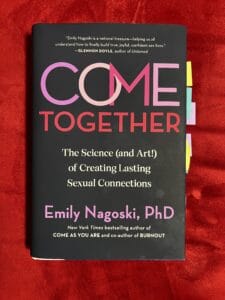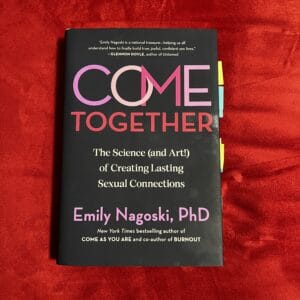Posts Tagged ‘books’
Capture Your Sexy Stories by Stella Fosse
Capture Your Sexy Stories
guest post by Stella Fosse

Shoes, hose, suit jacket, pencil skirt, all were cast aside. Hands were everywhere: caressing breasts, touching shoulders, massaging buttocks. Rachel’s hands slid behind Marion’s head and pulled her close. She found Marion’s lips with her own, lips that tasted of time, the spices of long ago, the herbs in the garden of her burnt English cottage.
– From Vampires of a Certain Age by Stella Fosse

Stella Fosse
Writing about our vibrant lives can be fun and liberating. When I lead workshops on sexy writing for olders, that joyful energy is all around us. We have so much experience to draw upon, so many memories and ideas. Sharing our sexy stories as older adults sends a powerful anti-ageist message.
You need not consider yourself a writer to enjoy writing about vivid moments. Approach your writing as play. Remember a sexy experience from yesterday or half a century ago. Make a list of sensory words and phrases your memory conjures. Was there music? Were there sighs? Laughter? What aromas and tastes do you recall? What about textures and surfaces you touched? Take your time with this list-making; there is no rush.
Use your list of words and phrases as writing prompts for your sexy scene. Expand on each thought in any order you want, chronological or not. What you write is just for your enjoyment unless you choose to share it. Feel free to add ideas from your imagination. Then read your scene aloud and enjoy your words.
Write about new sexual experiences soon after they happen to keep those moments fresh on the page. Sharing this writing with your partner can be a sexy experience. Expand on your scene to create a story, as I wrote about in a previous post for Joan Price’s blog.
You may even publish your sexy story! Every once in a while, a call for submissions comes along for erotic stories with older characters. You might enjoy these anthologies of sexy stories (and they may inspire your writing):
enjoy these anthologies of sexy stories (and they may inspire your writing):
• Ageless Erotica, edited by Joan Price
• Dirty Old Women: Erotica by Women of Experience, edited by Lynx Canon
• Ladies’ Own Erotica, by the Kensington Ladies Erotica Society
• Unmasked: Women Write about Sex and Intimacy After Fifty, edited by Marcia Meier and Kathleen A. Barry
 My first book, Aphrodite’s Pen: The Power of Writing Erotica after Midlife, includes erotic stories with older characters and writing prompts that turn society’s expectations about older characters upside down.
My first book, Aphrodite’s Pen: The Power of Writing Erotica after Midlife, includes erotic stories with older characters and writing prompts that turn society’s expectations about older characters upside down.
My newest book is Write & Sell a Well-Seasoned Romance, a step-by-step guide to create, edit, publish and market a late life Romance novel. Designed for new writers as well as experienced authors. this how-to manual includes sexy example scenes from my novel, Vampires of a Certain Age. Most Romance readers are past midlife, yet few Romance characters are over thirty. Your stories can help!
market a late life Romance novel. Designed for new writers as well as experienced authors. this how-to manual includes sexy example scenes from my novel, Vampires of a Certain Age. Most Romance readers are past midlife, yet few Romance characters are over thirty. Your stories can help!
Rachel thrilled at the heightened sense of touch she experienced in Marion’s arms. “Kiss me again. Please. Give me your tongue.” With a low murmur, Marion did as she was asked. Still kissing, the two made their way to Marion’s bed, which was large and inviting, a slightly darker peach than the walls, with a generous silken canopy. Lying on it, Rachel felt as if she were floating in space. Marion’s body was strong and soft, new and somehow familiar.
– From Vampires of a Certain Age by Stella Fosse
Writing about joyful, sexy moments is a great antidote to the negativity about aging all around us. Erotic writing helps us see our sex lives in a positive way and contributes to our health and longevity. It’s a fun revolution. Try it and enjoy!

Stella Fosse encourages people after midlife to subvert ageism through writing and sharing our vivid stories. She leads workshops, writes both fiction and nonfiction, and blogs on topics of interest to olders. She is the author of Write & Sell a Well-Seasoned Romance, Aphrodite’s Pen, and two novels and a story collection, all featuring vivid older characters. She shares her writing and other resources at www.stellafosse.com
LATitude by Vicki Larson
LATitude: How You Can Make a Live Apart Relationship Work
by Vicki Larson
Reviewed by Mac Marshall

Vicki Larson, photo credit Kim Thompson Steel
LAT stands for Live Apart Together. In her welcome book about this new lifestyle, Vicki Larson notes that at least three things must occur for a relationship to be considered LAT:
- Two people agree that they are a committed romantic couple;
- Others view them as a committed romantic couple;
- They intentionally reside in separate homes.
LAT has grown in popularity in recent years, especially among divorced or widowed older adults. Many seniors find that living separately from their romantic partner provides an attractive combination: committed companionship along with personal independence.
 “There are several studies indicating that living apart from your romantic partner benefits your sex life,” says Larson. “LAT couples often experience more passion, idealize their partners more, daydream about their relationship, and report more loving feelings toward their partner than couples who live together.” Larson’s own interviews revealed that compared to couples who live together, LAT couples:
“There are several studies indicating that living apart from your romantic partner benefits your sex life,” says Larson. “LAT couples often experience more passion, idealize their partners more, daydream about their relationship, and report more loving feelings toward their partner than couples who live together.” Larson’s own interviews revealed that compared to couples who live together, LAT couples:
- Have the same or even higher levels of commitment;
- Feel equal or greater trust for their partners;
- Have the same or higher levels of stability;
- Experience equal or more relationship satisfaction.
LAT relationships typically offer a couple equality, intimacy, stability, and more satisfying sex than if they resided under one roof. “Absence not only seems to make the heart grow fonder, it also makes the libido stronger.”
Larson lists the reasons most people state for getting married: love, “lifelong commitment, companionship, children, having the relationship be recognized by a religious ceremony, financial stability, and…legal rights and benefits.” She notes that living together is not mentioned as a reason to wed. Indeed, “all the stated reasons for marrying can be achieved while living apart from your romantic partner.” In LATitude, she presents examples of married couples who actively choose to live apart happily, often for decades.
To succeed in a LAT relationship, you must feel secure in your sexual relationship. “Ultimately, it comes down to this: Are you with someone you trust, and is that person worthy of your trust? And are you someone your partner can trust?” With or without marriage, LAT rests on mutual trust to abide by whatever agreements and boundaries a couple establish, including whether to be monogamous or consensually non-monogamous. Larson quotes a therapist who is in a longtime LAT partnership: “Before you take this step, you have to be really secure in your relationship. The commitment you need in your relationship can’t be half-assed. It takes more trust when you’re not going to see the person and you have no idea what they’re doing all day or night.”
If you are a senior intrigued by or contemplating an LAT relationship, Larson’s book is essential reading. She also addresses financial matters, legal issues, and decisions about caregiving as aging partners require more assistance. These are especially relevant to our age group. You’ll come away from her book with a solid understanding of the pros and cons of LAT as you chart your own course.
Larson’s book is essential reading. She also addresses financial matters, legal issues, and decisions about caregiving as aging partners require more assistance. These are especially relevant to our age group. You’ll come away from her book with a solid understanding of the pros and cons of LAT as you chart your own course.
My own experience: I am 80 years old. I had two long marriages. The first one ended in divorce and the second with my wife’s death. I have no desire to remarry. As a widower I am now in a delightful and fulfilling LAT relationship. I find it satisfying in a host of ways. My partner and I each live in our own home and see one another several times a week, including one or two “overnights.” We communicate daily. We maintain our separate friendship networks, along with friends in common. Sometimes we travel together, sometimes solo. We keep our finances separate and often treat each other to dates or trips. We schedule regular sex dates in advance. The anticipation of such planned intimacy adds to the excitement. Disadvantages to LAT? I can’t think of any!
Do you have a LAT arrangement? I invite you to comment.

Mac Marshall, PhD is a retired anthropology professor, researcher, and author who is delighted to explore sexuality studies at this time of his life.

Purchase LATitude: How You Can Make a Live Apart Relationship Work from Bookshop.org. Visit Vicki Larson’s website.
Come Together by Emily Nagoski

Emily Nagoski at Book Passage, Corte Madera, CA
Come Together: The Science (and Art) of Creating Lasting Sexual Connections
by Emily Nagoski, PhD
Reviewed by Mac Marshall
What is the key to passionate sex over the long term? Frequency? Orgasms? Novelty? Monogamy? Being a “skilled” lover?
Wrong, says Emily Nagoski, PhD in her new book, Come Together: The Science (and Art) of Creating Lasting Sexual Connections. Her goal is to give us the key to long-term satisfying sex. She writes,
Great sex in a long-term relationship is not about how much you desire sex or how often you have to do it. It’s not about what you do, in which position, with whom or where or in what clothes, even how many orgasms you have. It’s whether or not you like the sex you are having.
“Pleasure Is the Measure” is a major theme of Come Together. Pleasure is all about “how much you like the sex you’re having.” Most of the book teaches how to create access to pleasure with a long-term partner. Mutual admiration and trust are essential to this creative process.
Most of us seek both connection and pleasure in sexual relationships. But the excitement we feel when a relationship begins often fades as time goes by. Partners in committed relationships such as marriage frequently drift apart sexually. Typically, this is due to work pressures, the demands of family, and our physical changes as we age. Nagoski gives us helpful guidelines to revive and maintain connection and pleasure for the long haul.
haul.
Two chapters focus on what she calls “your emotional floorplan.” She bases this on the dual control model that she introduced in her best-known book, Come As You Are: turn-ons—the accelerator—and turn-offs—the brakes. The floorplan consists of seven emotional spaces that affect your sexuality: lust, care, play, rage, panic+grief, fear and seeking. She offers advice on how to navigate these emotional states as we construct a safe space with our partner for mutual sexual pleasure.
When people “come together” in partnerships Nagoski finds they seek:
- connection,
- shared pleasure,
- being wanted by another,
- freedom to feel full immersion in an erotic moment.
These are especially pertinent for relationships between seniors. Aging usually changes our needs for erotic connection. It is potentially empowering. For example, Nagoski observes:
[Aging provides] a context that encourages you to explore. Try new things. Shed all the preconceived ideas about how sex “should” work and experiment with all the ways it can and does work for you and your partners, in the bodies you have right now.
Come Together centers on persons of any gender in long-term relationships. She shows us ways to create partnerships that sustain a strong sexual connection. The partnership characteristics she focuses on are:
- they are friends
- they prioritize sex
- they pursue what’s genuinely true for them—what works in their unique relationship—rather than accepting other people’s opinions about how they’re supposed to do sex.

These characteristics flourish by avoiding “the desire imperative” and “the sex imperatives”:
- “The desire imperative” is the notion that we should feel a “spark” of spontaneous craving for sexual intimacy when a relationship begins. And if we don’t continue to feel that sparky desire, we’ve failed. The desire imperative pooh-poohs planning or preparing for sex, and if we and our partner don’t just spontaneously want each other effortlessly, we must not want each other enough. Against this “mess of wrongheadedness,” Nagoski centers pleasure as the alternative measure of sexual well-being.
- “The sex imperatives” that endanger lasting sexual connections are many, including these:
- the coital imperative (penis-in-vagina sex)
- the variety imperative (manual, oral, and anal play as well as PIV)
- the performance imperative (enhancing your sexual skill set)
- the monogamy imperative (you should only have one sexual relationship at a time)

Fixation on any or all of these can thwart success in building lasting sexual connections.
Change is an unavoidable given in life and relationships. Among the changes most of us encounter are illness, pain, and aging. Nagoski writes,
The key to sustaining a strong sexual connection over the long term is to adapt—with confidence, joy, and calm, warm curiosity—to the changes brought by each season of our lives.
To join together in a successful sexually rewarding long-term partnership, Nagoski champions trust, admiration, confidence and joy. She gives these tips for achieving mutual lasting pleasure and connection:
- Seek authenticity.
- Plan for and embrace the changes that will always occur.
- Find adaptations and adjustments that work for your unique situation.
Just as Nagoski’s Come as You Are is a ground-breaking book for women understanding their sexuality and achieving sexual pleasure, Come Together is the book you need to enrich the sexual joy in a long-term relationship. Read it — your sexual relationship will thank you!

Purchase Come Together at your local independent bookstore or order from Bookshop.org or Amazon.

Mac Marshall, PhD is a retired anthropology professor, researcher, and author who is delighted to explore sexuality studies at this time of his life.
Wild Monogamy: interview with Mali Apple

One of the challenges in a longtime monogamous relationship is creating newness and surprises. Another is continuing to deepen intimacy, communication, and empathy. Reading Wild Monogamy: Cultivating Erotic Intimacy to Keep Passion and Desire Alive by Mali Apple and Joe Dunn is like having Mali and Joe personally coach you through these issues and more. If you and your partner have hit a roadblock, or if you need information and a boost to take your relationship to the next level, this book is your valued guide.
In Wild Monogamy, Mali and Joe share stories that illustrate how partners can support one another in overcoming insecurities, inhibitions, shame, and self-consciousness that often accompany aging. I invited Mali to share some of her own aging issues and how the two of them cope.
Interview with Mali Apple,
co-author of Wild Monogamy:
Cultivating Erotic Intimacy to Keep Passion and Desire Alive
What’s one arena in which you help each other heal limiting ideas about yourselves?
I turned 60 this year. I have to admit that at times I feel a sense of shame about being an aging woman. I guess I drank the cultural Kool-Aid about older women not being attractive, desirable, or even worthy of pleasure!
These societal beliefs can be deeply ingrained. They might only emerge when we’re confronted with signs of our own ticking clock. The ever-more-unachievable images we’re bombarded with daily magnify our discomfort.
Since ageism in our culture disproportionately affects women, I have a tougher time than Joe when it comes to accepting my own aging face. When I can’t see beyond the newest spot or wrinkle, he’s right there beside me. His words and actions guide me toward accepting —even appreciating! — the woman looking back in the mirror.
What does Joe say to help you let go of your insecurities?
From Joe’s perspective at 65, age isn’t important. “When I look at you,” he’ll tell me, “I don’t see an aging woman, I see an amazing woman!” He insists that it’s the whole me that makes me beautiful to him. This includes my heart, my spirit, my energy, my ideas, and my enthusiasm for life.
Or he’ll say,
- “These lines on your face are a celebration of your life.”
- “Your body has brought me more pleasure over the years than I can possibly even remember.”
- “The beauty that radiates from within you is timeless.”
- “There’s no one else I’d rather get old with.”
When he catches me fixating on my age spots and wrinkles, he encourages me to speak to myself more kindly. “You have to put your wrinkles into perspective,” he’ll point out. “They’re such a tiny part of who you are!”
You might try affirmations like these with someone you love. When it’s coming from a person you trust, you can consciously choose to accept their perspective as truth. Joe gives me these reminders anytime I need them. This is a beautiful gift for partners to offer each other!
Do you have rituals or activities that help you embrace the changes that come with time?
Here is one ritual that helps us. We intentionally see each other as continually evolving works of art. Together we reflect on the truth that all our life experiences — the everyday ones, the challenging ones, and the extraordinary ones — have contributed to this masterpiece before us.
We also practice seeing each other as spiritual beings in human form moving through the natural stages of aging. This has been the genesis of more than a few heart-opening conversations!
During our sexy time, Joe will often encourage me to shift my focus from how I look to how I feel. For example, he’ll ask me to put all my attention on the sensations created by the silky scarf he’s trailing across my skin. When we clo

se our eyes and touch or kiss, he’ll point out that nothing tells us our age is a problem.
Joe and I also actively look for role models our age or older who are filled with vitality. Sometimes we’ll sit in a public place and observe the older people around us. We make a point to find something beautiful in every one of them.
Here’s one more sweet activity we enjoy together. We choose a few photos from when we were younger and immerse ourselves in them. We talk about where each was taken and how we felt about ourselves at the time. We get a sense of who we were during those moments. As we kiss and make love, we become the people in those images, connecting with who we were back then. Sharing our past selves in this way creates a uniquely healing and intimate experience in the present.
What is a key truth you’ve come to about aging?
The older we get, every moment we have together deepens and becomes more precious. We feel honored to be with each other on this journey. We’re excited to be a witness to the shifts, insights, and personal transformations to come. And we’re confident that plenty of sexy adventures await us!

Learn more about Mali Apple and Joe Dunn at https://maliandjoe.com/, and watch their many TikTok videos at https://www.tiktok.com/@maliandjoe. Purchase Wild Monogamy at your local independent bookstore or order from Amazon.


